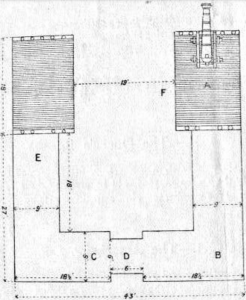Standing six feet tall and of slim build Sergeant Dugald Macpherson was described as careful, accurate and cool-headed. He kept a newspaper cutting in his notebook. It was a report on a competition between Volunteer Artillery companies. He would have treasured this article: a memento of the day he led an Easdale team to victory.
The Long Shift was a daunting competition. Each team had to dismount a three-ton, ten-foot long cast iron gun-barrel off its wooden carriage and shift it around an obstacle course. Parbuckling was one of the techniques: using two heavy ropes they could roll the barrel along wooden planks.
The competition booklet for 1895 sets the scene: an outdoor arena, fifteen yards long and fourteen yards wide. At one end are two wooden platforms, one in each corner. A 64-pounder artillery gun sits on one of them. Around the other three sides of the arena is a narrow passage, nine feet wide and marked by low walls. At one point the passage shrinks to a small gap, six feet wide and six feet long, with walls six feet high.
Imagine the day of the competition. It is half-past three. Nineteen strong men, led by Sergeant Macpherson, enter the arena. They take their places around the gun and focus on the stores that they will need: heavy ropes an inch and a half thick and eighteen feet long, strong handspikes, rollers made of elm, short planks of oak and long skids of fir. Captain Bailley, the umpire, blows his whistle and the men spring into well-rehearsed drills.
Ropes are tied around each end of the gun-barrel, the free ends held taught. The barrel is raised off its carriage with handspikes and lowered down planks which form a ramp, the descent controlled by the ropes, until it rests on the ground on rollers. Ropes are wound three times around each end, and heaved to roll the barrel over long skids which act as railway lines, the ropes re-wound as soon as they unravel. Handspikes are jabbed and twisted to keep the barrel going straight, for the thicker end by the breech rolls differently to the thinner end at the muzzle. More skids are placed in front as the parbuckle progresses down the side of the arena, around the first corner, and carefully through the narrow gap.
Now planks are bound together to form a temporary sleigh. The gun-barrel is hauled on top of it, dragged around the second corner and along the remainder of the passage. The sleigh is dismantled and the barrel manhandled onto a low platform, swivelled round the final corner, pulled off the wooden platform and dragged across to the starting point. Finally, three tons of cast iron is hauled up watered skids and shoved back into position on the gun-carriage.
It was a well executed Shift which earned the Easdale team ninety-one points – the highest score ever for this competition. The first prize of £30 was richly deserved.

Above – the competition booklet shows the layout of the arena.
Top photo – why have gun barrels been dismounted from their carriages and left haphazardly on the lower slopes of Easdale hill? Probably to practise parbuckling!
